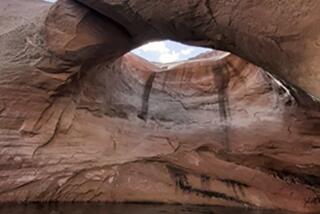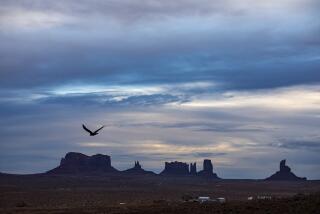River Trip Uncovers Utah Past
- Share via
BLUFF, Utah — Spirits of an ancient tribe whispered in the rushes as I softly pushed through the thick undergrowth and started up a faint path that wound among the red boulders and up the steep cliff face.
The ripple of the river faded as I climbed. Finally, I reached an echoing open cave of sandstone, 30 feet high and 100 long. I had found the home of the Anasazi Indians, who lived along the San Juan River in southern Utah nearly 1,000 years ago.
Shards of pottery--some painted, some pinched and corrugated--littered the ground. Stones once used to grind grain sat in shallow grooves in the flat rocks where they were last used.
Low adobe walls formed small rooms within the caves, and overhead on the vast arch of the roof, red spirals and crude human figures combined art and religion. Handprints of men 1,000 years dead called out silently. I fitted my palm over a red hand-petroglyph. His hand was smaller.
The Anasazi, also known as “Pueblo People,” were basket-making hunter-gatherers who experimented with rudimentary farming. Anasazi is a Navajo word meaning ancient ones .
The overhanging cliffs protected them from weather and enemies. Toe- and hand-holds cut into the cliffs provided the only access to the dwellings.
I visited these caves, which are protected from desecration by the Federal Antiquities Act, by river raft.
Although travelers can tour ruins in Colorado and Arizona, movement and access often is restricted to protect the ancient places. Only here in the wilderness can one sit alone above the rolling river, doze in the rooms of people who lived 500 years before Columbus, and absorb their rich history.
Only here can one can sit and watch the same river sunset above the rolling waves once watched by men who have now been dead 1,000 years.
Rafting expeditions from Bluff to Mexican Hat, Utah, take two to four days.
Our trip started in a wide valley surrounded by wind-carved cliffs. Anasazi steps, often no more than pounded-out toe-holds, angled precipitously up the cliffs and carved and painted petroglyphs adorned the overhanging walls. Trails led our explorers off through the brush to the vast cliff dwellings.
Halfway into the 27-mile trip, canyon walls closed in and the current picked up speed. In high water, three- or four-foot-high “sand waves” formed by the shifting river bottom popped up and disappeared at random.
At our last river camp, near Mexican Hat Rock, we were awakened by the loud sound of a large rock thrown into the shallow water near our tent. Though we scanned the camp in the starlight, we found no intruder. Only in the morning light did the truth show its brown head as a wary beaver slapped his flat tail on the water once more.
The San Juan is an easy river, visited more for its beauty than for its minimal white water.
Camping spots are plentiful. Great blue herons wade the shallows, eagles soar the thermals, and deer stare from the underbrush. Beaver slides and a variety of paw prints carve the banks.
Two of our explorers hiked up a side canyon to some ruins, and, retracing their steps a few minutes later, found large cat tracks overlaying their own footprints.
Because the San Juan is gentle, it is an excellent place for first-time rafters to try their hand at rowing or paddling. The moderate currents make it hard to get into trouble, and the variety of camping spots and access-by-permit-only ensure a true wilderness experience.
More to Read
Sign up for The Wild
We’ll help you find the best places to hike, bike and run, as well as the perfect silent spots for meditation and yoga.
You may occasionally receive promotional content from the Los Angeles Times.






